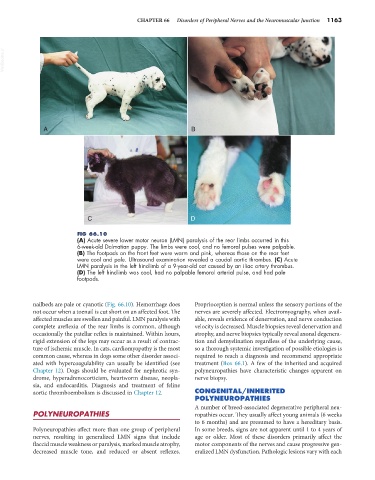Page 1191 - Small Animal Internal Medicine, 6th Edition
P. 1191
CHAPTER 66 Disorders of Peripheral Nerves and the Neuromuscular Junction 1163
VetBooks.ir
A B
C D
FIG 66.10
(A) Acute severe lower motor neuron (LMN) paralysis of the rear limbs occurred in this
6-week-old Dalmatian puppy. The limbs were cool, and no femoral pulses were palpable.
(B) The footpads on the front feet were warm and pink, whereas those on the rear feet
were cool and pale. Ultrasound examination revealed a caudal aortic thrombus. (C) Acute
LMN paralysis in the left hindlimb of a 9-year-old cat caused by an iliac artery thrombus.
(D) The left hindlimb was cool, had no palpable femoral arterial pulse, and had pale
footpads.
nailbeds are pale or cyanotic (Fig. 66.10). Hemorrhage does Proprioception is normal unless the sensory portions of the
not occur when a toenail is cut short on an affected foot. The nerves are severely affected. Electromyography, when avail-
affected muscles are swollen and painful. LMN paralysis with able, reveals evidence of denervation, and nerve conduction
complete areflexia of the rear limbs is common, although velocity is decreased. Muscle biopsies reveal denervation and
occasionally the patellar reflex is maintained. Within hours, atrophy, and nerve biopsies typically reveal axonal degenera-
rigid extension of the legs may occur as a result of contrac- tion and demyelination regardless of the underlying cause,
ture of ischemic muscle. In cats, cardiomyopathy is the most so a thorough systemic investigation of possible etiologies is
common cause, whereas in dogs some other disorder associ- required to reach a diagnosis and recommend appropriate
ated with hypercoagulability can usually be identified (see treatment (Box 66.1). A few of the inherited and acquired
Chapter 12). Dogs should be evaluated for nephrotic syn- polyneuropathies have characteristic changes apparent on
drome, hyperadrenocorticism, heartworm disease, neopla- nerve biopsy.
sia, and endocarditis. Diagnosis and treatment of feline
aortic thromboembolism is discussed in Chapter 12. CONGENITAL/INHERITED
POLYNEUROPATHIES
A number of breed-associated degenerative peripheral neu-
POLYNEUROPATHIES ropathies occur. They usually affect young animals (6 weeks
to 6 months) and are presumed to have a hereditary basis.
Polyneuropathies affect more than one group of peripheral In some breeds, signs are not apparent until 1 to 4 years of
nerves, resulting in generalized LMN signs that include age or older. Most of these disorders primarily affect the
flaccid muscle weakness or paralysis, marked muscle atrophy, motor components of the nerves and cause progressive gen-
decreased muscle tone, and reduced or absent reflexes. eralized LMN dysfunction. Pathologic lesions vary with each

